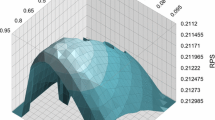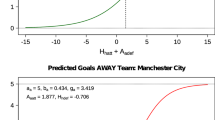Abstract
Motivated by the fact that some shots are better than others, the expected goals (xG) metric attempts to quantify the quality of goal-scoring opportunities in soccer. The metric is becoming increasingly popular, making its way to TV analysts’ desks. Yet, a vastly underexplored topic in the context of xG is how these models are affected by the data on which they are trained. In this paper, we explore several data-related questions that may affect the performance of an xG model. We showed that the amount of data needed to train an accurate xG model depends on the complexity of the learner and the number of features, with up to 5 seasons of data needed to train a complex gradient boosted trees model. Despite the style of play changing over time and varying between leagues, we did not find that using only recent data or league-specific models improves the accuracy significantly. Hence, if limited data is available, training models on less recent data or different leagues is a viable solution. Mixing data from multiple data sources should be avoided.
Access this chapter
Tax calculation will be finalised at checkout
Purchases are for personal use only
Similar content being viewed by others
Notes
- 1.
Since penalties and free-kicks are relatively easy to predict, our xG models might seem less accurate than other models which include these penalty and free-kick shots.
- 2.
This version of the Brier score is only valid for binary classification. The original definition by Brier is applicable to multi-category classification as well.
References
Brier, G.W.: Verification of forecasts expressed in terms of probability. Mon. Weather Rev. 78(1), 1–3 (1950)
Caley, M.: Premier league projections and new expected goals (2015). Accessed 27 May 2020. https://cartilagefreecaptain.sbnation.com/2015/10/19/9295905/premier-league-projections-and-new-expected-goals
Chen, T., Guestrin, C.: XGBoost: a scalable tree boosting system. In: Proceedings of the 22nd ACM SIGKDD International Conference on Knowledge Discovery and Data Mining, KDD 2016, ACM, New York, NY, USA ,pp. 785–794 (2016). https://doi.org/10.1145/2939672.2939785
Decroos, T., Bransen, L., Van Haaren, J., Davis, J.: Actions speak louder than goals: Valuing player actions in soccer. In: Proceedings of the 25th ACM SIGKDD International Conference on Knowledge Discovery & Data Mining, pp. 1851–1861 (2019)
Decroos, T., Davis, J.: Interpretable prediction of goals in soccer. In: Proceedings of the AAAI-20 Workshop on Artificial Intelligence in Team Sports, December 2019
Fairchild, A., Pelechrinis, K., Kokkodis, M.: Spatial analysis of shots in MLS: a model for expected goals and fractal dimensionality. J. Sports Anal. 4(3), 165–174 (2018)
Gelade, G.: Which team formations produce the most expected goals? July 2017. http://business-analytic.co.uk/blog/which-team-formations-produce-the-most-expected-goals/
Green, S.: Assessing the performance of premier league goalscorers, April 2012. https://www.optasportspro.com/news-analysis/assessing-the-performance-of-premier-league-goalscorers/
Ijtsma, S.: A close look at my new expected goals model, August 2015. http://www.11tegen11.com/2015/08/14/a-close-look-at-my-new-expected-goals-model/
Kullowatz, M.: Expected goals 3.0 methodology, April 2015. https://www.americansocceranalysis.com/home/2015/4/14/expected-goals-methodology
Manfredi, G.: Expected goals & player analysis, May 2019. https://www.kaggle.com/gabrielmanfredi/expected-goals-player-analysis
Pedregosa, F., et al.: Scikit-learn: machine learning in Python. J. Mach. Learn. Res. 12, 2825–2830 (2011)
Statsbomb: Danish football analysis, April 2019. https://divisionsforeningen.dk/wp-content/uploads/2019/04/Superliga_Analysis.pdf
Webb, G.I., Ting, K.M.: On the application of ROC analysis to predict classification performance under varying class distributions. Mach. Learn. 58(1), 25–32 (2005)
Acknowledgements
This research received funding from the KU Leuven Research Fund (C14/17/070) and the Flemish Government under the “Onderzoeksprogramma Artificiële Intelligentie (AI) Vlaanderen” programme.
Author information
Authors and Affiliations
Corresponding author
Editor information
Editors and Affiliations
A Hyperparameters
A Hyperparameters
Logistic Regression + Basic Features

XGBoost + Basic Features

Logistic Regression + Advanced Features

XGBoost + Advanced Features

Rights and permissions
Copyright information
© 2020 Springer Nature Switzerland AG
About this paper
Cite this paper
Robberechts, P., Davis, J. (2020). How Data Availability Affects the Ability to Learn Good xG Models. In: Brefeld, U., Davis, J., Van Haaren, J., Zimmermann, A. (eds) Machine Learning and Data Mining for Sports Analytics. MLSA 2020. Communications in Computer and Information Science, vol 1324. Springer, Cham. https://doi.org/10.1007/978-3-030-64912-8_2
Download citation
DOI: https://doi.org/10.1007/978-3-030-64912-8_2
Published:
Publisher Name: Springer, Cham
Print ISBN: 978-3-030-64911-1
Online ISBN: 978-3-030-64912-8
eBook Packages: Computer ScienceComputer Science (R0)




